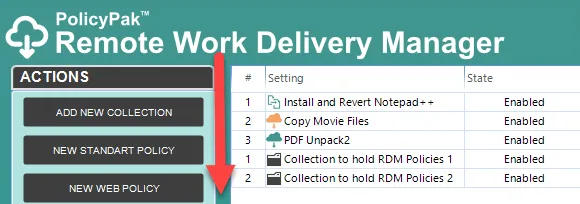Understanding Processing Order and Precedence within a GPO
Within a particular GPO (User side or Computer side), policies and collections process in numerical order. So, lower-numbered policies attempt to process first, and higher-numbered policies attempt to process last. Then, lower-numbered collections attempt to process first, and higher-numbered collections attempt to process last.

Within any collection, there may be other collections, as well as policies. As such, each policy and collection is also processed in numerical order, starting at each level with the lowest-numbered policies and collections.
Understanding Merging and Conflicts
Netwrix Endpoint Policy Manager (formerly PolicyPak) Remote Work Delivery Manager will simply merge all Endpoint Policy Manager Remote Work Delivery Manager policies that come from the Group Policy method (and policies deployed from the non-Group Policy methods and collections), unless there is a conflict. If there is a conflict, the last policy wins.
Precedence Between Delivery Types
Endpoint Policy Manager Remote Work Delivery Manager policies can be delivered by Group Policy and non-Group Policy methods such as MEMCM (via Endpoint Policy Manager Exporter or Endpoint Policy Manager MDM) or Endpoint Policy Manager Cloud. As such, the Endpoint Policy Manager Remote Work Delivery Manager engine needs to make a final determination regarding whether there is any conflict between Endpoint Policy Manager Remote Work Delivery Manager policies (which are essentially rules). Here is how precedence works:
- Polices delivered by Endpoint Policy Manager Cloud have the lowest precedence.
- Endpoint Policy Manager file-based policies (including those delivered from an MDM service) have the next highest precedence.
- Endpoint Policy Manager Group Policy policies have the highest precedence.